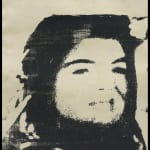Andy Warhol
"Jackie 1964", 1963/64
Synthetic polymer and silkscreen ink on heavy stock. This work is registered with The Andy Warhol Foundation as a painting.
46 x 37 cm
18 1/8 x 14 5/8 in
18 1/8 x 14 5/8 in
Copyright The Artist
$ 450,000.00
Further images
-
(View a larger image of thumbnail 1
)

-
(View a larger image of thumbnail 2
)

-
(View a larger image of thumbnail 3
)

-
(View a larger image of thumbnail 4
)

-
(View a larger image of thumbnail 5
)

-
(View a larger image of thumbnail 6
)

-
(View a larger image of thumbnail 7
)

-
(View a larger image of thumbnail 8
)

-
(View a larger image of thumbnail 9
)

-
(View a larger image of thumbnail 10
)

-
(View a larger image of thumbnail 11
)

-
(View a larger image of thumbnail 12
)

-
(View a larger image of thumbnail 13
)

-
(View a larger image of thumbnail 14
)

-
(View a larger image of thumbnail 15
)

-
(View a larger image of thumbnail 16
)

-
(View a larger image of thumbnail 17
)

-
(View a larger image of thumbnail 18
)

-
(View a larger image of thumbnail 19
)

-
(View a larger image of thumbnail 20
)

-
(View a larger image of thumbnail 21
)

-
(View a larger image of thumbnail 22
)

-
(View a larger image of thumbnail 23
)

-
(View a larger image of thumbnail 24
)

-
(View a larger image of thumbnail 25
)

-
(View a larger image of thumbnail 26
)

Similar work on manila is depicted in The Andy Warhol Catalogue Raisonne Vol 02A on page 948. When Andy Warhol learned that President John F. Kennedy had died on November...
Similar work on manila is depicted in The Andy Warhol Catalogue Raisonne Vol 02A on page 948.
When Andy Warhol learned that President John F. Kennedy had died on November 22nd 1963, the first thing the artist said was "well, let's get to work." Warhol was fascinated by JFK's assassination and the media coverage of the event. He later observed, "It didn't bother me that much that he was dead. What bothered me was the way television and radio were programming everyone to feel so sad. It seemed no matter how hard you tried, you couldn't get away from the thing."
But Warhol did not depict the assassination of the President in his paintings. Instead, he chose to focus on the president's wife Jackie Kennedy. He picked out images of the First Lady that were taken shortly before and after her husband's death and cropped them to zoom in on her face. He then screen-printed them onto canvases. and the resulting portraits display a range of emotions—from Jackie smiling while wearing a pillbox hat, to her inscrutable expression, obscured by a black veil, on the day of her husband's funeral. Each image is on a different colored canvas and the screen printing process left some of the impressions in bold black ink, and others blurry.
Warhol painted multiple images of Jackie Kennedy throughout his career, and while many of them celebrated her as an American icon, the images of her that he created shortly after her husband's death resonate deeply with sadness, not only for the president's death but also for the commodification of the first lady's grief.
Photo 4 & 5 of comparable paintings on paper.
When Andy Warhol learned that President John F. Kennedy had died on November 22nd 1963, the first thing the artist said was "well, let's get to work." Warhol was fascinated by JFK's assassination and the media coverage of the event. He later observed, "It didn't bother me that much that he was dead. What bothered me was the way television and radio were programming everyone to feel so sad. It seemed no matter how hard you tried, you couldn't get away from the thing."
But Warhol did not depict the assassination of the President in his paintings. Instead, he chose to focus on the president's wife Jackie Kennedy. He picked out images of the First Lady that were taken shortly before and after her husband's death and cropped them to zoom in on her face. He then screen-printed them onto canvases. and the resulting portraits display a range of emotions—from Jackie smiling while wearing a pillbox hat, to her inscrutable expression, obscured by a black veil, on the day of her husband's funeral. Each image is on a different colored canvas and the screen printing process left some of the impressions in bold black ink, and others blurry.
Warhol painted multiple images of Jackie Kennedy throughout his career, and while many of them celebrated her as an American icon, the images of her that he created shortly after her husband's death resonate deeply with sadness, not only for the president's death but also for the commodification of the first lady's grief.
Photo 4 & 5 of comparable paintings on paper.
Provenance
Acquired by the former owner directly from the artist in 1967.The work was requested for examination by Thomas Ammann Art in 1988
In 1996 the work was examined by Georg Frei from The Andy Warhol Catalogue Raisonne.
In 1998 The Andy Warhol Catalogue Raisonne confirms by writing that the work is registered in their archives.
Sothebys London.
Phillips Auction London. Art Day Sale 9 March 2018 lot no. 198.



























